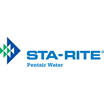
January 25th, 2024
Water booster pumps are a great way to boost the water pressure in your water system. They may be end-suction, in-line, horizontal split-case, or single/multi-stage vertical turbine pumps. Booster pumps with VFD are used in applications where the existing water pressure is low and requires a boost. Such applications include municipal systems, well water systems, rainwater collection systems, and garden and irrigation applications.
A variable frequency drive (VFD) or variable speed drive (VSD) helps a booster pump adjust pressure to the actual demand. It takes care of the frequency of the power supplied to the booster pump. Modern booster pumps VFD are a marvel of technology. They can often be a bit intimidating to those unfamiliar with power electronics. Therefore, it is better to examine the factors that can contribute to the pump performance of a drive unit.
The role of VFD is to control the speed of an AC motor by adjusting the frequency of the electrical power supplied to it, regulating the pump’s output. A pump increases water pressure by moving water through the system. The motor converts electrical energy into mechanical energy to drive the pump.
Pressure sensors monitor the pressure in the system and provide feedback to the VFD for real-time adjustments. Control panels contain the interface for setting parameters and monitoring the pump system. Lastly, electrical wiring connects all components, ensuring proper power supply and control signals.
Keep in mind that a drive is a sensitive electronic device. It is designed to respond to fluctuations in system conditions and usually drops off on a fault indication. So, how do we diagnose issues with this type of drive?When fixing a Variable Frequency Drive (VFD) booster pump, you must follow a systematic troubleshooting process. Here are some general steps you can take to diagnose and troubleshoot common issues with your booster pump VFD:
If you are having issues with your VFD booster pump, you must first check the pump system with a visual inspection. It includes looking for running or dripping water, high humidity, temperature extremes, and corrosive agents near or under the pump. A good rule of thumb is to check if the power supply to the VFD is stable and within the specified range.
Depending on the environment, your VFD pump may face significant contaminant problems. Make sure the frequency drive is relatively clean. Don’t let dirt and dust build up on the heatsink of the drive. This prevents the cooling of the drive semiconductors and often causes damage to the cooling fans.
Since the VFD pump performs day in and day out, the constant cycle of increase in temperature and subsequent cooling can lead to loss of connections over time. Loose wiring connections of the booster pump VFD to the incoming power and the motor are some common issues associated with drive failure. So, it is better to examine the wiring connections. Look for loose or damaged connections, including tripped circuit breakers. Make sure that the wiring follows the manufacturer’s specifications and guidelines.
You should also check the line voltages coming into the frequency drive. Unbalanced line voltages may cause problems, so these voltages should be balanced within 5%. Check the current level coming into the input, as they can differ from phase to phase. Additionally, don’t forget to check the drive output for voltage. It should be balanced within a couple of volts. Significant variations may result in the motor shaking violently.
Check the VFD programming to confirm that the parameters are set correctly. This includes verifying motor parameters, frequency settings, acceleration and deceleration times, etc. Make adjustments as needed based on the desired pump specifications provided by the manufacturer. Also, check for fault codes that booster pumps VFD often display in case of issues. Check the display for error codes and consult the VFD manual to interpret them.
When troubleshooting your VFD booster pump, refer to the manufacturer’s documentation for specific guidelines, recommendations, and technical details relevant to your pump model. A successful VFD booster pump system operation requires a good understanding of the equipment, adherence to guidelines, and regular maintenance. If in doubt, consult with a qualified professional.
To invest in branded booster pumps with VFD, contact us today.
john@callaghanpump.com,
eileen@callaghanpump.com,
dan@callaghanpump.com,
sales@callaghanpump.com,
service@callaghanpump.com












